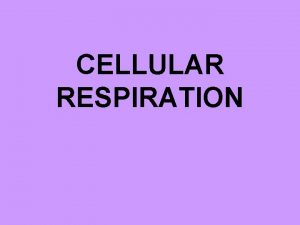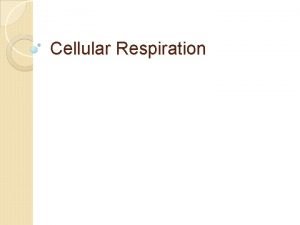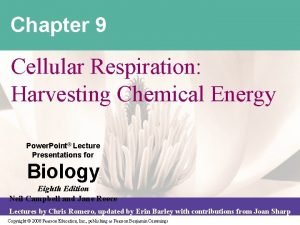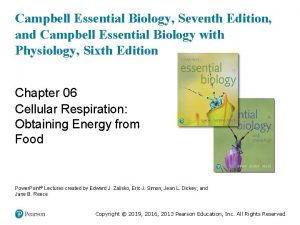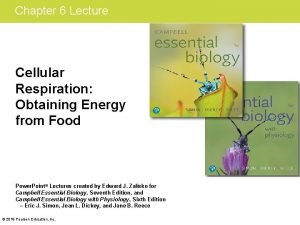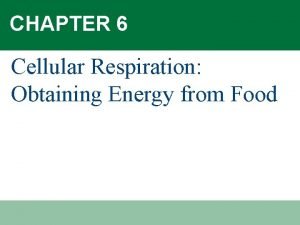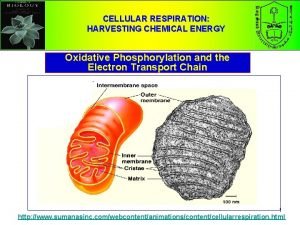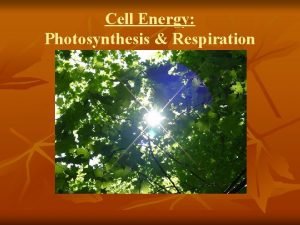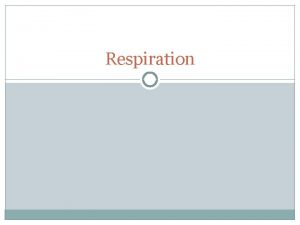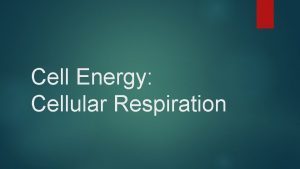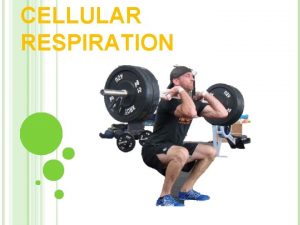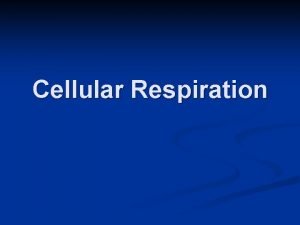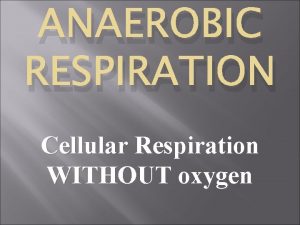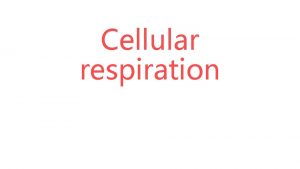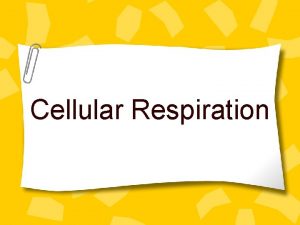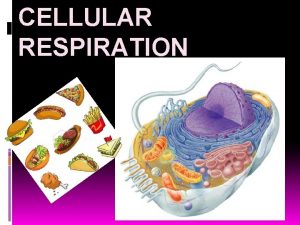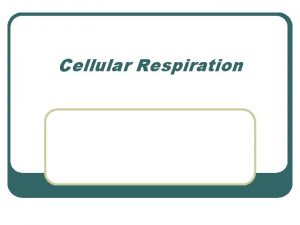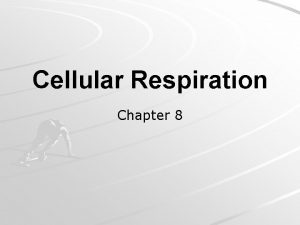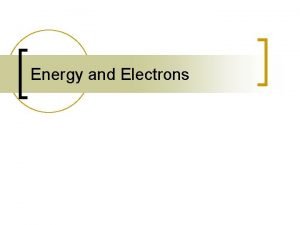Cell Energy Cellular Respiration Cellular Respiration Overview Electrons


![Cellular Respiration Overview Electrons Glycolysis Glucose Pyruvate Krebs Cycle [Matrix] Mitochondria Electron Transport Chain Cellular Respiration Overview Electrons Glycolysis Glucose Pyruvate Krebs Cycle [Matrix] Mitochondria Electron Transport Chain](https://slidetodoc.com/presentation_image_h2/674d9897ddb0baffb812b27ef38e6baf/image-3.jpg)







![Cellular Respiration Overview Electrons Glycolysis Glucose Pyruvate Krebs Cycle [Matrix] Mitochondria Electron Transport Chain Cellular Respiration Overview Electrons Glycolysis Glucose Pyruvate Krebs Cycle [Matrix] Mitochondria Electron Transport Chain](https://slidetodoc.com/presentation_image_h2/674d9897ddb0baffb812b27ef38e6baf/image-11.jpg)



![Cellular Respiration Overview Electrons Glycolysis Glucose Pyruvate Krebs Cycle [Matrix] Mitochondria Electron Transport Chain Cellular Respiration Overview Electrons Glycolysis Glucose Pyruvate Krebs Cycle [Matrix] Mitochondria Electron Transport Chain](https://slidetodoc.com/presentation_image_h2/674d9897ddb0baffb812b27ef38e6baf/image-15.jpg)


![Cellular Respiration Overview Electrons Glycolysis Glucose Pyruvate Krebs Cycle [Matrix] Mitochondria Electron Transport Chain Cellular Respiration Overview Electrons Glycolysis Glucose Pyruvate Krebs Cycle [Matrix] Mitochondria Electron Transport Chain](https://slidetodoc.com/presentation_image_h2/674d9897ddb0baffb812b27ef38e6baf/image-18.jpg)



- Slides: 21

Cell Energy: Cellular Respiration

![Cellular Respiration Overview Electrons Glycolysis Glucose Pyruvate Krebs Cycle Matrix Mitochondria Electron Transport Chain Cellular Respiration Overview Electrons Glycolysis Glucose Pyruvate Krebs Cycle [Matrix] Mitochondria Electron Transport Chain](https://slidetodoc.com/presentation_image_h2/674d9897ddb0baffb812b27ef38e6baf/image-3.jpg)
Cellular Respiration Overview Electrons Glycolysis Glucose Pyruvate Krebs Cycle [Matrix] Mitochondria Electron Transport Chain (ETC) [Inner membrane] lasm p o t Cy 34 ATP 2 ATP Image modified from—Campbell Biology: Concepts and Connections, 5 th ed. (Online textbook). Retrieved 30 March 2010 from: http: //media. pearsoncmg. com/bc/bc_campbell_concepts_5/media/art/ch 6/ir/imagelib_tab_1/14. htm

Comparing photosynthesis and cell respiration The energy flow in these reactions take place in opposite directions The equation for photosynthesis and cellular respiration are the reverse of each other Photosynthesis releases oxygen and cellular respiration uses the oxygen to release the energy in food Photosynthesis: uses carbon dioxide and cellular respiration replaces it. Cellular Chloroplast Respiration: Mitochondria


Draw in your notes

Cellular respiration overview Goal: Convert food (C 6 H 12 O 6) into energy ATP Overall Reaction: C 6 H 12 O 6 In + 6 02 6 CO 2 +6 H 20 + ENERGY (ATP) the presence of oxygen: Aerobic- 34 -38 ATP Glycolysis Krebs cycle ETC Without oxygen- Anaerobic- 2 ATP Glycolysis Fermentation: Alcoholic and Lactic Acid

Big Picture GLUCOSE Glycolysis Not a lot of ATP made Then With oxygen Aerobic Respiration Without oxygen Fermentation Alcoholic Lactic Acid

Glycolysis- the first step in releasing energy Only a small amount of energy is released in this step (2 ATP) Happens Location: first whether oxygen is present or not In the cytoplasm of the cell (not yet in the mitochondria) Reactants: Glucose Products: 2 Pyruvate 2 NADH (NAD+, Electrons, and Hydrogen) as an electron carrier 4 ATP are made – 2 ATP are used = 2 ATP

![Cellular Respiration Overview Electrons Glycolysis Glucose Pyruvate Krebs Cycle Matrix Mitochondria Electron Transport Chain Cellular Respiration Overview Electrons Glycolysis Glucose Pyruvate Krebs Cycle [Matrix] Mitochondria Electron Transport Chain](https://slidetodoc.com/presentation_image_h2/674d9897ddb0baffb812b27ef38e6baf/image-11.jpg)
Cellular Respiration Overview Electrons Glycolysis Glucose Pyruvate Krebs Cycle [Matrix] Mitochondria Electron Transport Chain (ETC) [Inner membrane] lasm p o t Cy 34 ATP 2 ATP Image modified from—Campbell Biology: Concepts and Connections, 5 th ed. (Online textbook). Retrieved 30 March 2010 from: http: //media. pearsoncmg. com/bc/bc_campbell_concepts_5/media/art/ch 6/ir/imagelib_tab_1/14. htm

In the presence of oxygen the cycle will continue into the mitochondria!

Krebs Cycle Named after Hans Krebs- Also known as the Citric Acid Cycle Pyruvate is broken down into Carbon Dioxide in a series of energy extracting reactions Takes place in the matrix or space in the mitochondria Reactants: Products: One The Pyruvate (3 carbon sugar) and oxygen CO 2, NADH, FADH 2 (from FAD+), and 2 ATP carbon from the Pyruvate attaches to an O 2 molecule: CO 2 remaining carbons go through a series of events to release more CO 2 and add electrons to NAD+ NADPH, and FAD+ FADH 2 to fuel the next cycle

Image taken from www. sp. uconn. edu
![Cellular Respiration Overview Electrons Glycolysis Glucose Pyruvate Krebs Cycle Matrix Mitochondria Electron Transport Chain Cellular Respiration Overview Electrons Glycolysis Glucose Pyruvate Krebs Cycle [Matrix] Mitochondria Electron Transport Chain](https://slidetodoc.com/presentation_image_h2/674d9897ddb0baffb812b27ef38e6baf/image-15.jpg)
Cellular Respiration Overview Electrons Glycolysis Glucose Pyruvate Krebs Cycle [Matrix] Mitochondria Electron Transport Chain (ETC) [Inner membrane] lasm p o t Cy 34 ATP 2 ATP Image modified from—Campbell Biology: Concepts and Connections, 5 th ed. (Online textbook). Retrieved 30 March 2010 from: http: //media. pearsoncmg. com/bc/bc_campbell_concepts_5/media/art/ch 6/ir/imagelib_tab_1/14. htm

Electron Transport Chain (ETC) Takes place on the Cristae of the mitochondria The electron carriers FADH 2 and NADH take the high energy electrons from the Krebs Cycle to the electron transport chain to convert ADP into ATP As electrons are passed from carrier to carrier, the energy is used to pump hydrogen ions (H+) across the membrane of the mitochondria. This high concentration of H+ flow through a protein, ATP Synthase, to convert ADP into ATP Forming Since 34 ATP oxygen is present, some of it will attach to the H+ H 20

![Cellular Respiration Overview Electrons Glycolysis Glucose Pyruvate Krebs Cycle Matrix Mitochondria Electron Transport Chain Cellular Respiration Overview Electrons Glycolysis Glucose Pyruvate Krebs Cycle [Matrix] Mitochondria Electron Transport Chain](https://slidetodoc.com/presentation_image_h2/674d9897ddb0baffb812b27ef38e6baf/image-18.jpg)
Cellular Respiration Overview Electrons Glycolysis Glucose Pyruvate Krebs Cycle [Matrix] Mitochondria Electron Transport Chain (ETC) [Inner membrane] lasm p o t Cy 34 ATP 2 ATP Image modified from—Campbell Biology: Concepts and Connections, 5 th ed. (Online textbook). Retrieved 30 March 2010 from: http: //media. pearsoncmg. com/bc/bc_campbell_concepts_5/media/art/ch 6/ir/imagelib_tab_1/14. htm

What if after glycolysis, there is NO oxygen? ? Anaerobic conditions lead to. . . Fermentation 1. Alcoholic 2. Lactic Acid ***No more ATP produced after glycolysis

Summary

Photosynthesis and Cellular Respiration “Cycle” Products of one become reactants of the other!
 Overview of cellular respiration
Overview of cellular respiration Overview of respiration
Overview of respiration Cellular respiration
Cellular respiration Overview of cellular respiration
Overview of cellular respiration All cells must contain
All cells must contain Where in the cell does cellular respiration occur
Where in the cell does cellular respiration occur Cellular respiration formula
Cellular respiration formula Cellular respiration harvesting chemical energy
Cellular respiration harvesting chemical energy Energy flow in cellular respiration
Energy flow in cellular respiration Chemical cycling in an ecosystem
Chemical cycling in an ecosystem Explain how amp stimulates cellular respiration
Explain how amp stimulates cellular respiration Chapter 9: cellular respiration: harvesting chemical energy
Chapter 9: cellular respiration: harvesting chemical energy Cellular respiration obtaining energy from food
Cellular respiration obtaining energy from food Cellular respiration obtaining energy from food
Cellular respiration obtaining energy from food Electron transport chain summary
Electron transport chain summary How do plants get glucose
How do plants get glucose Chapter 8 section 1: how organisms obtain energy
Chapter 8 section 1: how organisms obtain energy Cellular respiration redox
Cellular respiration redox The gray-brown haze often found over large cities is called
The gray-brown haze often found over large cities is called Chemiosmosis steps
Chemiosmosis steps Cellular respiration product
Cellular respiration product Was ist fermentieren
Was ist fermentieren




